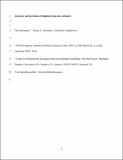Files in this item
Accuracy and precision of dolphin group size estimates
Item metadata
| dc.contributor.author | Gerrodette, Tim | |
| dc.contributor.author | Perryman, Wayne L. | |
| dc.contributor.author | Oedekoven, Cornelia S. | |
| dc.date.accessioned | 2019-05-13T23:37:58Z | |
| dc.date.available | 2019-05-13T23:37:58Z | |
| dc.date.issued | 2019-01 | |
| dc.identifier | 253087923 | |
| dc.identifier | 4f79c0a9-dba7-4618-a896-a63083795eb3 | |
| dc.identifier | 85059902163 | |
| dc.identifier | 000459614400002 | |
| dc.identifier.citation | Gerrodette , T , Perryman , W L & Oedekoven , C S 2019 , ' Accuracy and precision of dolphin group size estimates ' , Marine Mammal Science , vol. 35 , no. 1 , pp. 22-39 . https://doi.org/10.1111/mms.12506 | en |
| dc.identifier.issn | 0824-0469 | |
| dc.identifier.other | crossref: 10.1111/mms.12506 | |
| dc.identifier.other | ORCID: /0000-0002-5610-7814/work/61978856 | |
| dc.identifier.uri | https://hdl.handle.net/10023/17695 | |
| dc.description.abstract | Estimating the number of dolphins in a group is a challenging task. To assess the accuracy and precision of dolphin group size estimates, observer estimates were compared to counts from large‐format vertical aerial photographs. During 11 research cruises, a total of 2,435 size estimates of 434 groups were made by 59 observers. Observer estimates were modeled as a function of the photo count in a hierarchical Bayesian framework. Accuracy varied widely among observers, and somewhat less widely among dolphin species. Most observers tended to underestimate, and the tendency increased with group size. Groups of 25, 50, 100, and 500 were underestimated by <1%, 16%, 27%, and 47%, respectively, on average. Precision of group size estimates was low, and estimates were highly variable among observers for the same group. Predicted true group size, given an observer estimate, was larger than the observer estimate for groups of more than about 25 dolphins. Predicted group size had low precision, with coefficients of variation ranging from 0.7 to 1.9. Studies which depend on group size estimates will be improved if the tendency to underestimate group size and the high uncertainty of group size estimates are included in the analysis. | |
| dc.format.extent | 18 | |
| dc.format.extent | 1676209 | |
| dc.language.iso | eng | |
| dc.relation.ispartof | Marine Mammal Science | en |
| dc.subject | Group size estimation | en |
| dc.subject | Abundance estimation | en |
| dc.subject | Aerial photography | en |
| dc.subject | Bayesian hierarchical model | en |
| dc.subject | Random-effects model | en |
| dc.subject | Reversible jump MCMC | en |
| dc.subject | QH301 Biology | en |
| dc.subject | NDAS | en |
| dc.subject | BDC | en |
| dc.subject.lcc | QH301 | en |
| dc.title | Accuracy and precision of dolphin group size estimates | en |
| dc.type | Journal article | en |
| dc.contributor.institution | University of St Andrews. School of Mathematics and Statistics | en |
| dc.contributor.institution | University of St Andrews. Centre for Research into Ecological & Environmental Modelling | en |
| dc.identifier.doi | 10.1111/mms.12506 | |
| dc.description.status | Peer reviewed | en |
| dc.date.embargoedUntil | 2019-05-14 |
This item appears in the following Collection(s)
Items in the St Andrews Research Repository are protected by copyright, with all rights reserved, unless otherwise indicated.

